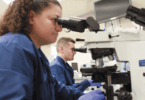Breast cancer is life changing. Even after successful treatment, some women are not happy with what they see, often avoiding the mirror. Terms like “Barbie doll,” “science project” or “disfigured” have been used describing their reflection. Seeing and hearing these comments after breast reconstruction surgery, Heather Foley, FNP-BC, RNFA, the nurse practitioner at UHS Plastic & Reconstructive Surgery, decided to take things into her own hands—literally—by learning how to tattoo.
“Often, I assist the breast/general surgeon with the mastectomy, and I assist our plastic surgeons with the subsequent reconstruction,” she says. “A few years ago, I saw a patient who had 3D areolar tattoos done out of the area. I thought, ‘I can do that.’” The tattoos are done on patients’ reconstructed breasts, creating the illusion of a three-dimensional areola using ink.
After doing some research, Ms. Foley attended an accredited micropigmentation school to learn how to perform the complex 3D tattooing technique.
“The 3D technique makes the tattoo more realistic,” she explains. “Women generally do not have the same shape or size breasts they had prior to breast cancer. Creating an areolar complex using different color inks and shading brings them closer to a more realistic result.”
Ms. Foley performs the tattooing at her office, located in UHS Binghamton General Hospital.
This provides a medical environment for the procedure that may be more comfortable than a tattoo studio or a spa and allows the procedure to be billed through the insurance, creating a continuity of care for patients. Many are patients of the plastic surgeons in her office, with whom she has an established working relationship.
“Once cleared by the plastic surgeon, we schedule an initial consult, review their history, identify their needs and explain the process,” she says. “On tattoo day, they come into a very relaxed environment. For patients who are apprehensive about getting a tattoo or experience hypersensitivity, I have a variety of distractions, including topical numbing cream. It’s the final stage of a long, reconstructive process, and together with our team of plastic surgeons, this makes our office unique.”
For Ms. Foley, the best part of her job is seeing her patients’ reactions after the tattoo is done. “Seeing their faces when they look in the mirror is priceless,” she says. “It’s either tears of joy or a big ‘Wow!’ When a woman loses that part of their womanhood, they may be cancer-free, but they don’t feel whole. My goal for patients is not to avoid the mirror, but to see the new version of themselves. It is amazing how a small amount of ink can have such a huge impact in a woman’s life: regaining self-esteem and confidence, and feeling whole again.”
GET CHECKED
Breast cancer affects about 1 in 8 women in the U.S. over the course of their lifetime. Learn more about recommendations for mammography in “Cancer Doesn’t Wait,” or visit nyuhs.org.







